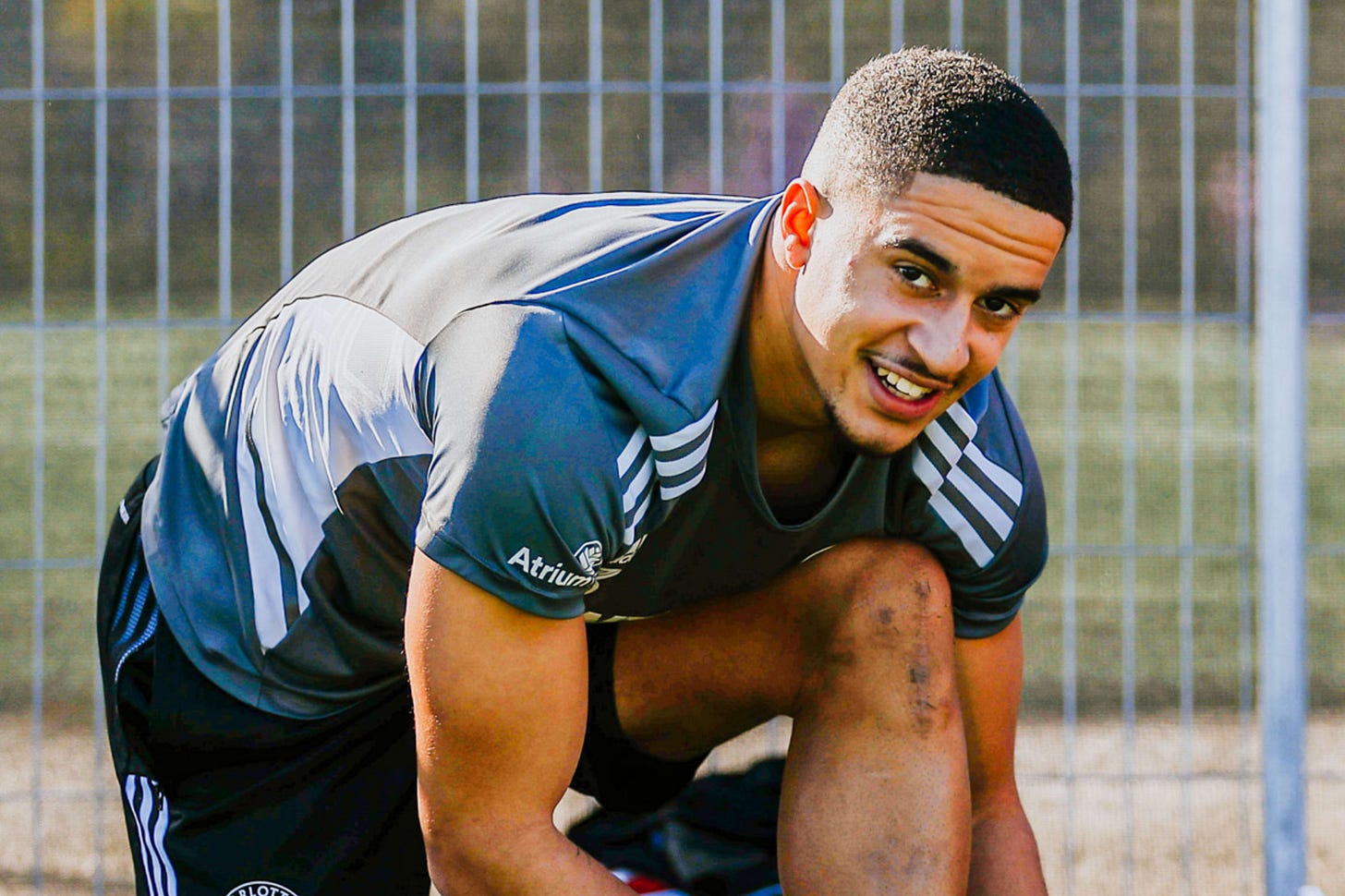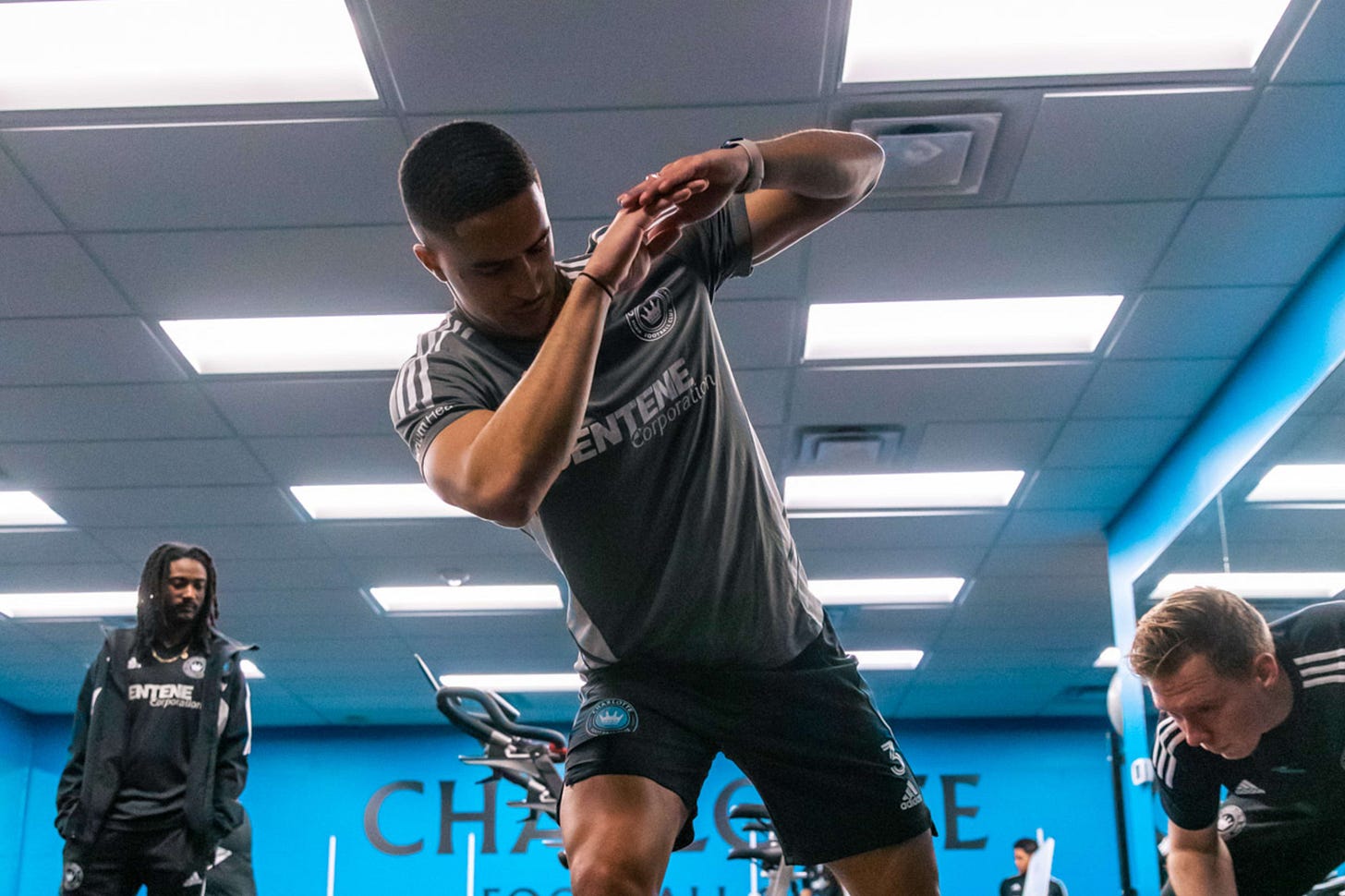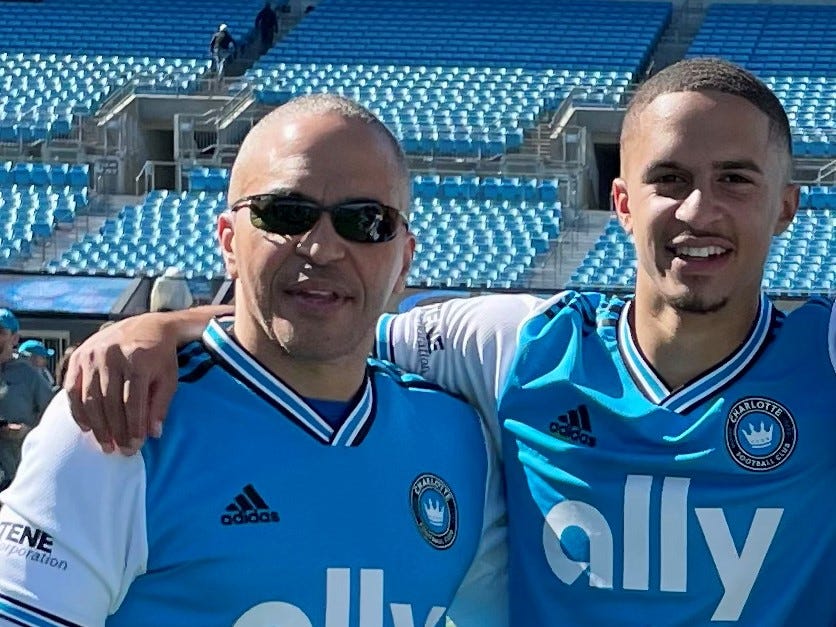Rebuilding Adam Armour
Charlotte FC's promising young defender battles back from last year's devastating knee injury; 'It's ultimately going to be a test of his resolve'
It’s time for Fútbol Friday, The Charlotte Ledger’s weekly newsletter getting you up to speed on Charlotte FC, the city’s new pro soccer team.
➡️ Need to sign up for Fútbol Friday and other Charlotte-focused email newsletters from The Charlotte Ledger? You can do that here.
➡️ Ledger subscribers can add or drop individual newsletters on their “My Account” page.
He scored Charlotte FC’s first-ever goal last year. Then he blew out his knee. Can Adam Armour work his way back?
Adam Armour putting his surgically repaired left knee to the test. (Photo courtesy of Charlotte FC.)
After Adam Armour headed in a corner cross last March 13 against Atlanta United — rising from obscurity into history by scoring the first ever goal for Charlotte FC — he went into celebration overload.
He flashed double A’s for “Adam Armour” with two fingers down on each hand. He pointed his thumbs to the name on the back of his jersey. He covered his eyes. He “rubbed the waves” of his hair. And lastly, almost sadly now looking back, he looped his fingers in front of his eyes like “Big Billionaire glasses” as his teammate Anton Walkes tried to coax him from behind a camera into doing “The Griddy” — a celebration dance made popular in the NFL.
It was almost as if something inside of Armour knew he needed to make the moment last. He was a defender — an unlikely choice to score the team’s first goal — but was already showing flashes of the skills that landed him on the Under-17 U.S. National team for the 2019 World Cup. It was a promising beginning to the season.
What nobody could see at the time was that Armour’s left knee was a ticking time bomb.
Surprising news from an MRI
The first clue came a little more than two weeks later when Armour felt a “tweak” changing direction one day in practice.
At 19, he was the youngest player on the roster, trying to turn a moment into a mark.
He was also the son of an orthopedic surgeon. He knew the smart thing to do was to say something to the medical staff, and he did. An MRI revealed a surprise: Armour had no functioning anterior cruciate ligament, one of the primary stabilizing forces, in his left knee.
“I didn’t even know it was a possibility,” said Armour. “I thought, ‘Oh well, that’s a good thing. That means I can’t tear my ACL.’”
The Carolina Panthers’ head team orthopedist, Dr. Durham Weeks, explained to Armour that either he was born without an ACL, or probably more likely, had suffered a tear of it previously and never knew it. That he could still rise to the ranks of Major League Soccer puts him in a category with those Armour’s dad and other experts refer to as “neuromuscular geniuses.” Mickey Mantle is one; he was believed to have played 17 years in Major League Baseball with a torn ACL.
Apparently, the muscles around Armour’s knee had helped him compensate for the lack of stability. He hoped they would again.
“(Weeks) just said ‘manage your load,’” said Armour, who was told he could manage pain with injections if need be and try to make it through the season before re-assessing. “But after that, I never really had any pain or discomfort, so in my mind, it went away.”
But “managing his load” proved complicated.
Two weeks later, on April 20, Charlotte FC was playing a U.S. Open Cup game in Greenville, S.C. The game was part of a single-elimination tournament independent from the Major League Soccer schedule. Younger players are often given the opportunity for more minutes, especially in the early rounds. Armour was named a starter for the opener.
After averaging just 16 minutes in five games off the bench, Armour played 90 minutes through a 1-1 tie in regulation and another 30 minutes of extra time because the game couldn’t end in a tie.
“I’m not going to tell (then-coach Miguel Angel Ramirez) to sub me out,” Armour said. “Especially when I'm not feeling any pain or discomfort.”
In the 118th minute with Charlotte up 2-1, Armour was dribbling forward when he slowed down to avoid defenders.
“It was just one step where I felt everything go wrong in my knee,” Armour said.
When head athletic trainer Tyler Knight got to him on the field, Armour was cramping in both of his calves and hamstrings.
“I remember telling one of the other athletic trainers on the bench,” Knight said. “He said, ‘How did his knee look?’ And I said, ‘It felt loose, but it's hard to tell because he was guarding so much because he was in bilateral full leg cramps.’”
Armour hobbled through the final minutes of the game. But when the cramps and adrenaline subsided, and the swelling and soreness persisted, he went in for another MRI. It revealed he had torn both the lateral and medial meniscus in his left knee. Surgery was scheduled for May 1.
At that point, doctors also did an MRI on his right knee. That ACL was intact.
Extensive surgery requires three repairs
Charlotte FC head physician and orthopedic surgeon Dr. Jonathan Riboh of OrthoCarolina used a portion of Armour’s patellar tendon to reconstruct an ACL — similar to the surgery to repair a torn ACL — and he repaired both of his meniscus tears.
Armour in the weight room, where he spent much of his time this winter. (Photo courtesy of Charlotte FC.)
Armour’s father, Dr. Ted Armour, a sports fellowship-trained orthopedic surgeon for UNC Health in Cary, who actually performed an ACL operation later that week, was not allowed in his son’s operating room by North Carolina law. He and Adam’s mother, Shelly Armour, waited more than three hours in the waiting room. A typical ACL surgery might take 90 minutes.
Afterward, Riboh showed them a sequence of post-op pictures.
“His knee looked like you’d let a bomb off in it,” Dr. Armour said. “I think Dr. Riboh did a good job. It looked good. I mean, it was tough. It’s tough looking at the pictures inside your kid’s knee.”
Dr. Armour said the physician in him has questions about the steps leading up to the blow out. The father in him knows it’s best to move forward.
“It’s true, hindsight is 20/20,” Dr. Armour said. “If you go to see 10 orthopedic surgeons, you might get six different ways of doing things. … Admittedly, I wish I had been a little bit more involved earlier. I could have helped at least ask a few informed questions.”
Dr. Armour had been watching the game in Greenville on TV and knew right away what was happening when his son went down.
“I think the hardest part is you understand the potential ramifications for a young player,” Dr. Armour said. “Somebody at the beginning of their career to have that kind of injury, the hardest part is you have to now come back and do really well and establish your value.”
Hobbled at home, watching horror movies on Netflix
Armour went home to Cary to stay with his dad after surgery, largely because he was living in the ranch house where Adam and his brother Ethan grew up, and it was easy to get around on crutches.
His parents had recently separated. His dad was preparing to sell the house, so the room that had been Adam’s since he was 6 years old was cleaned out and repainted.
“It was tough,” Armour said. “I’ve always tried to look at the positives. I still go home and get to see both (parents). But yeah, that’s why this year has been very challenging. But I’ve been trying to stay positive.”
Adam Armour (right) with his arm around his father, Dr. Ted Armour. (Photo courtesy of Ted Armour.)
Dr. Armour came home to check on Adam during his lunch hour and spent evenings and weekends with him.
“You’re trying to be a good dad,” he said, “with a little know-how.”
Normally, an ACL surgical patient is on his feet the first few days after surgery. Because of the meniscus repairs, Armour couldn’t put any weight on his leg for six weeks. The first two weeks, he couldn’t take a shower.
When he needed an escape, he watched horror movies on Netflix. When he wanted to face what he was dealing with, he opened Instagram and watched video of his first goal.
“It was showing myself what I was capable of,” Armour said. “Sometimes it serves as a reminder, ‘I know I’m going through it right now. But there could be more of these moments to come if I put 100% into this recovery.’”
When he returned to Charlotte two weeks later to begin his rehab, team athletic trainers challenged him from the start — first with swinging “battle ropes” from a chair to work on his cardio shape and eventually on a stationary bike, comparing his progress from one week to the next.
Once Armour got back on the field, his biggest hurdle came in running a pole drill, where he gets up to full speed and then has to decelerate, like he did when he blew out his knee.
At first, Knight said, it was easy to see Armour’s hesitation. He would try to slow down early. But like with his speed and stamina, his confidence started to come back, too.
“I had to get past that mental block and know that I'm okay,” Armour said.
A test of resolve
Keeping tabs on his rehab from a distance has been Adam’s dad. When asked this week how he thought his son was doing, he said: “Better than I could have ever hoped. I think if everything holds, he’s going to do really well. I think this is a test. It’s asking: How much do you want this? How much do you want to get back? I think it’s ultimately going to be a test of his resolve because he’s going to get a little sore and it’s going to get a little achy. What he has going for himself is he had this injury at 19, not at 28, 29.”
Armour in preseason drills in Florida. (Photo courtesy of Charlotte FC.)
Charlotte FC coach Christian Lattanzio has kept close tabs on Armour throughout the process, too. He’s given Armour some confidence and even more motivation by envisioning him in a new role with the team this season. Lattanzio wants Armour to play winger, a more attacking position than where he was last year on the backline.
“I think he has got the special talent to score goals,” Lattanzio said.
Feb. 1 was nine months since the operation. A typical ACL recovery is six to nine months, but given the added cartilage repair, Knight said the team gave Armour a more conservative projection of nine to 12 months.
The first week of preseason in Florida, he was right on track, doing everything shy of full 11-on-11 work with his teammates. But he suffered a setback during a drill when he felt a pain jumping. Another MRI revealed no structural problems. Scare averted.
For now, while the team is in California, Armour is doing individual work on the side again. But when the players return home to Charlotte next week, he expects to get back into team activities. His goal is to be full speed by the opener on Feb. 25.
“I’ve seen guys who come back from an ACL or meniscus injury, and their careers go up,” Armour said. “I told myself I want to be one of those guys.”
Carroll Walton is a longtime baseball writer with the Atlanta Journal-Constitution now cutting her teeth on soccer and the Charlotte FC just as fans in Charlotte do. She would love to hear from you. E-mail her with questions, suggestions, story ideas and comments!
Need to sign up for this e-newsletter? We offer a free version, as well as paid memberships for full access to all 4 of our local newsletters:
➡️ Opt in or out of different newsletters on your “My Account” page.
➡️ Learn more about The Charlotte Ledger
The Charlotte Ledger is a locally owned media company that delivers smart and essential news through e-newsletters and on a website. We strive for fairness and accuracy and will correct all known errors. The content reflects the independent editorial judgment of The Charlotte Ledger. Any advertising, paid marketing, or sponsored content will be clearly labeled.
Like what we are doing? Feel free to forward this along and to tell a friend.
Social media: On Facebook, Instagram, Twitter and LinkedIn.
Sponsorship information/customer service: email support@cltledger.com.






